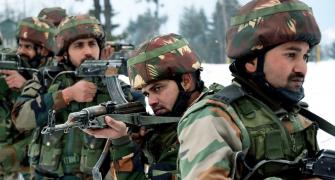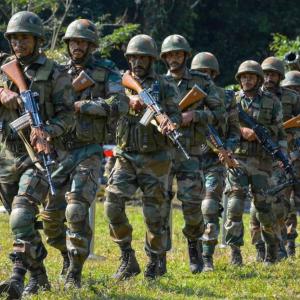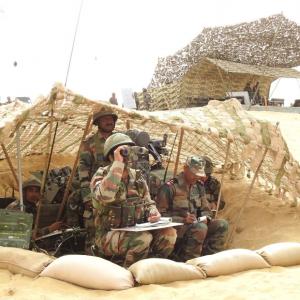The greatest unknown in this risky initiative lies in the way human relationships will play out -- not just between the Agniveers, who will be competing with their fellows for permanent jobs beyond their four-year tenures -- but also between the Agniveers and existing full-time soldiers, warns Ajai Shukla.

The government, deaf to protests, is going ahead with implementing the so-called Agnipath Yojana recruitment scheme that it announced without warning on June 14.
Without much explanation of its benefits and drawbacks, the ministry of defence (MoD) has presented it as a 'transformative measure' that will change the recruitment pattern of Agniveers (hereafter, soldiers, sailors and airmen who join under the Agnipath Yojana) from the current long-service -- 15-year bond that culminates in a lifelong pension -- to a mainly short-service contract under which annual tranches of recruits will serve for four years.
After that, 75 per cent of them go home without a pension.
This has evoked sharp anger amongst unemployed youth, who have already missed out on more than 100,000 military recruitment vacancies over the two years of lockdown, and will miss out on more until recruitment begins afresh.
Pensions have become, especially after the implementation of 'One Rank, One Pension' in 2015, an unaffordable chunk of the annual defence budget.
In the current year's (financial year 2022-2023) defence allocation of Rs 525,120 crore, a whopping 23 per cent -- about Rs 119,696 crore -- is allocated for pensions.
Add to that the salary payroll for serving soldiers, sailors, airmen and civilians (hereafter, soldiers), and personnel costs rise to 54 per cent of the entire defence budget.
The objective of the Agnipath Yojana is clearly to whittle down pension liabilities. Of each annual batch of recruits -- 46,000 recruits for each of the first four years, 90,000 in the fifth year; and 125,000 from the sixth year onwards -- one-quarter will be chosen to be retained in service.
This means that, from the 10th year onwards, Agnipath will yield 31,250 soldiers each year (25 per cent of 125,000) for extended service tenures, while another 93,750 will head home after completing their four-year service tenures.
The defence ministry has decided that the selected Agniveers will be enrolled in the army, navy and air force under their respective Service Acts for a period of four years. They will form a distinct rank in the military, different from any other existing ranks.
Upon completing four years of service, Agniveers will be offered an opportunity to apply for permanent enrolment in the military.
Selection will be the exclusive jurisdiction of the armed forces.
Enrolment will be based on 'All India, All Class' basis and the eligible age will be between 17 years and six months to 21 years.
The defence ministry claims there will be a range of benefits from Agnipath.
It says the rank and file would be younger, fitter, more mentally robust and more technologically savvy, with the average age dropping from the current 32 years to a youthful 27.
These youthful soldiers, the MoD argues, would provide a bank of disciplined employees, who could side-step smoothly into government and factory jobs.
To ease this transition, the government has reserved jobs for retiring Agniveers, including 10 per cent of vacancies in the Central Armed Police Forces, the Coast Guard, in defence ministry civilian posts and in 16 defence public sector undertakings.
Some 85 private firms have promised jobs to retiring Agniveers.
To ease his transition into civilian life, the defence ministry will give each Agniveer a 'Seva Nidhi' package at the end of the four-year engagement, amounting to a tax-free Rs 11 lakh-Rs 12 lakh (Rs 1.1 million to Rs 1.2 million).
Even so, the Agniveer's remuneration, which starts at Rs 30,000 per month and rises over three years to Rs 40,000 per month, ensures that he (women are not yet covered by this scheme) remains at a lower pay grade than even the junior-most soldier in the unit.
Financial implications apart, the Agnipath Yojana should not be implemented at the cost of a unit's combat effectiveness.
For a military like India's, which is operationally committed around the year on two-and-a-half fronts -- China, Pakistan and in Jammu and Kashmir -- treating soldiers equally has always been an article of faith and a basic principle of combat leadership.
If there are two separate pay grades for soldiers who perform the same battlefield functions, it will not be long before the one drawing lower pay turns on his better paid compatriot.
He will reason -- and, sooner or later voice his belief -- that since the other is paid better, he must take on higher risk in operations and discharge his battlefield functions better as well.
This will be the inevitable outcome of introducing differential recruitment and service models within the same combat unit.
The greatest unknown in this risky initiative lies in the way human relationships will play out -- not just between the Agniveers, who will be competing with their fellows for permanent jobs beyond their four-year tenures -- but also between the Agniveers and existing full-time soldiers.
It should be obvious to military leaders, steeped in the regimental system that is itself based on long-term loyalties that Agnipath pits batchmates against one another, creating incentives for each other's failure rather than for each other's success.
Instead of soldiers functioning like brothers-in-arms and comrades who put their lives on the line for each other, the structure of the Agnipath Yojana encourages compatriots to view each other as competitors, the success of one coming at the expense of another.
Everyone knows that out of every four batchmates, only one is going to be retained in service and that too on more favourable terms than hithertofore. How this plays out will perhaps hold the keys to the success or failure of Agnipath.
Every country that has implemented major military personnel and manpower reforms has done so with great deliberation and awareness of the high cost of failure.
Nowhere are the risks so high as in India, where the defence allocations are tiny, relative to the size of the force.
Yet, incredibly, the Agnipath Yojana was announced hurriedly without even a small-scale pilot project to validate the key assumptions and beliefs.
Instead of circulating the proposed project widely and holding consultations and discussions, the military has rushed headlong towards implementation.
It is still not too late to take a step back and obtain buy-in from the most important stakeholders -- the military's combat units.











